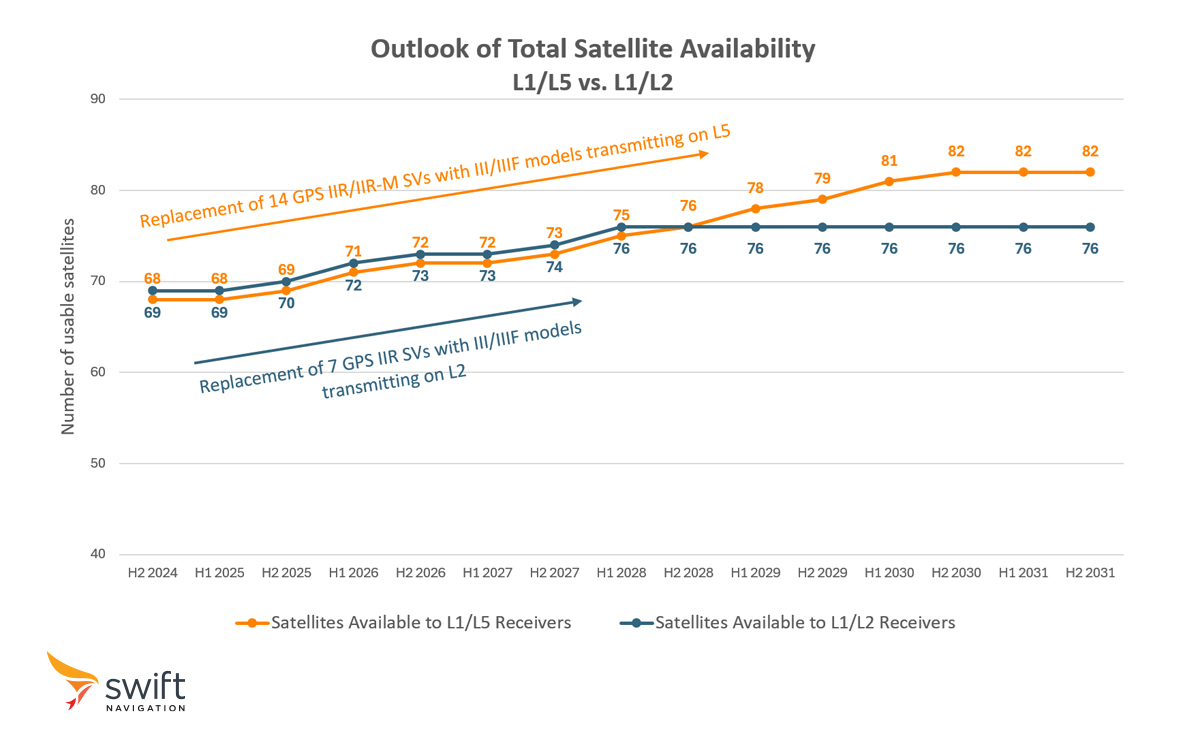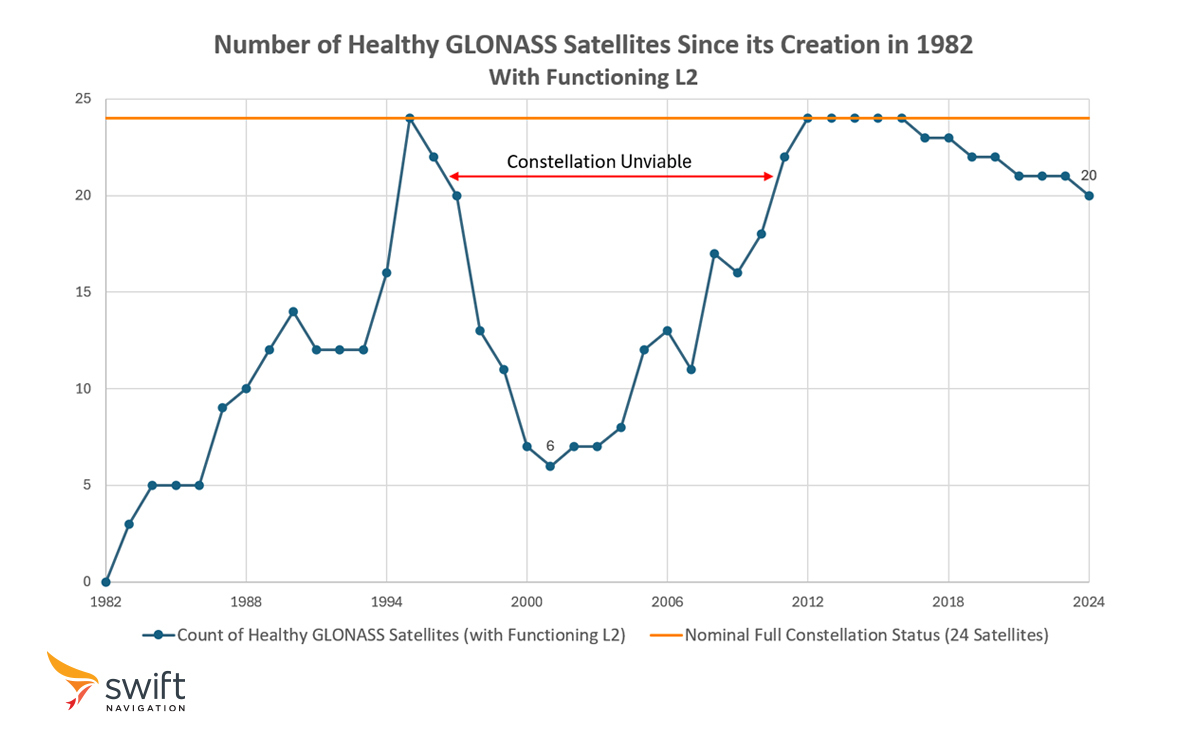
Blog
L1/L2 or L1/L5? Evaluating Dual-Frequency GNSS for High Precision Applications

Achieving reliable high-precision positioning is essential for navigation and operations in complex environments. With the commoditization of dual-frequency GNSS (Global Navigation Satellite System) receivers, the choice of signal combinations—L1/L2 and L1/L5—has become increasingly important as positioning technology evolves.
This article evaluates the differences between L1/L5 and L1/L2, and discusses how the L1/L5 combination is emerging as a strong option for modern applications requiring high precision and reliability.
Typical receiver configurations
Satellite and signal availability are critical factors influencing both reliability and convergence time in GNSS applications. Multi-constellation, multi-band receivers are engineered to optimize signal availability, improving performance in challenging environments. Common dual-band receivers typically offer a choice between L1/L2 or L1/L5, providing flexibility to meet different positioning requirements. Below are some typical receiver configurations:

* BeiDou has only 3 MEO satellites that transmit on L2 (BDS-2 B2I), which is not enough for applications outside of China
L5 support will soon overtake L2 across constellations
As of this writing, there are 68 usable L5 satellites compared to the 69 of L2. However, in the next few years L5 will overtake L2, driven by the modernization of GPS. The replacement of older satellites will add 14 new satellites and further improve L5 coverage. This gap is further increased by the fact that GLONASS does support any version of L5 and does not show any signs of doing so in the near future.

L1/L2’s reliance on GLONASS introduces significant risk
While GLONASS support may increase the satellite count for L1/L2 receivers, it comes with notable risks due to the constellation’s declining reliability. Over the past 30 years, GLONASS support for L2 has been highly inconsistent and the constellation has suffered from frequent delays and malfunctions. Currently, 4 out of the 24 GLONASS satellites are defective and do not transmit L2OF signals. The remaining 20 satellites account for 30% of the 69 signals typically processed by L1/L2 receivers, introducing substantial risk to these configurations.

Since 2016, GLONASS has been below full constellation status as the number of satellites with functional L2OF have been steadily declining with no replacements anticipated in the near future. This is exacerbated by current international sanctions on Russia due to the Ukraine war, making it more difficult to replace GLONASS satellites and modernize the constellation. These factors make L1/L2 dual frequency receiver systems depending on GLONASS less reliable compared to next generation systems using L1/L5, which instead utilize GPS, Galileo, and Beidou.
L5 is less susceptible to interference
L2 operates on an unprotected spectrum, making it more vulnerable to interference compared to L5, which resides in a protected spectrum. L2 is particularly susceptible to interference from various military and civilian systems operating on nearby or overlapping bands, including:
- Aviation TACAN and DME beacons
- Air Route Surveillance Radars (ARSR)
- Mobile Satellite Services (MSS) such as Iridium or Inmarsat
- Military Radars
Even amateur radio broadcasting has been known to occasionally disrupt L2 signals. For example a radio tower housing an amateur radio digipeater operating at 1240.4 MHz—a narrowband interferer within the GLONASS L2 band—caused a temporary L2 outage in the Netherlands (source). These types of radio interference are not illegal and can require months of investigation by emissions authorities to identify and resolve the root cause.
L5 has better performance than L2 in multipath and obstructed environments
L5 is better designed to meet the demands of modern performance requirements. Its properties make it particularly suited to autonomous robotics operating in complex environments like urban areas or under foliage. Three key factors which contribute to L5’s superior performance are:
Wider Bandwidth: L5 signals have a much wider bandwidth (10 MHz compared to L2C's 1 MHz). This allows for better resolution of multipath signals, making it easier to distinguish the direct signal from reflected signals
Advanced Modulation: L5 employs Binary Phase Shift Keying (BPSK(10)), a modulation technique that offers greater resistance to multipath interference compared to the Binary Offset Carrier (BOC) or Binary Phase Shift Keying (BPSK(1)) used on L2.
Higher Power: L5 signals are transmitted at higher power than L2C (-154 vs. -158 dBW), making them less susceptible to attenuation (loss of signal strength as it travels from a source to a receiver). This enhances signal reliability in challenging environments such as urban canyons, dense foliage, and indoor or semi-covered locations where weaker signals may struggle to maintain accuracy.
These enhancements make L5 a more robust and reliable option for modern navigation and positioning applications.
The market is shifting to L5 and away from L2
As L5 emerges as the GNSS standard, adopting L1/L5 provides future-proofing and ensures compatibility with next-generation technologies and applications. This shift is driving leading chipset manufacturers such as u-blox, Telit, and Quectel to prioritize L5 over L2 in their designs, delivering superior performance and user experiences.
Modern receivers catering exclusively to L1/L5 include:
- u-blox’s next generation F10 platform
- Telit’s flagship SE868K5-RTK
- Quectel’s popular LC29H
The growing adoption of L1/L5 is supported by rising production, simplified designs, and ongoing modernization, making these receivers increasingly affordable. In many cases, they are now more cost-effective than L1/L2 configurations. Furthermore, chipset manufacturers investing in L5 technology have streamlined the transition from L2 to L5, offering footprint-compatible upgrade paths with minimal redesign and increasingly affordable pricing for developers. This evolution ensures a smoother and more efficient shift to the L5 standard.
Conclusion
While L1/L2 has been a valuable technology to date, the L1/L5 combination is the clear choice for modern GNSS applications, offering superior reliability, robust interference resistance, and better performance. With L2’s limitations, including GLONASS reliability issues and unprotected spectrum vulnerabilities, the transition to L1/L5 is both necessary and inevitable to ensure the best performance for today’s and tomorrow’s autonomous technologies.
As L5 adoption accelerates, supported by GNSS modernization and advancements from leading chipset manufacturers, it is becoming increasingly accessible and cost-effective to implement. By transitioning to L1/L5, developers can future-proof their autonomous systems, ensuring compatibility with emerging technologies while achieving the accuracy and performance needed for next-generation robotics applications.

